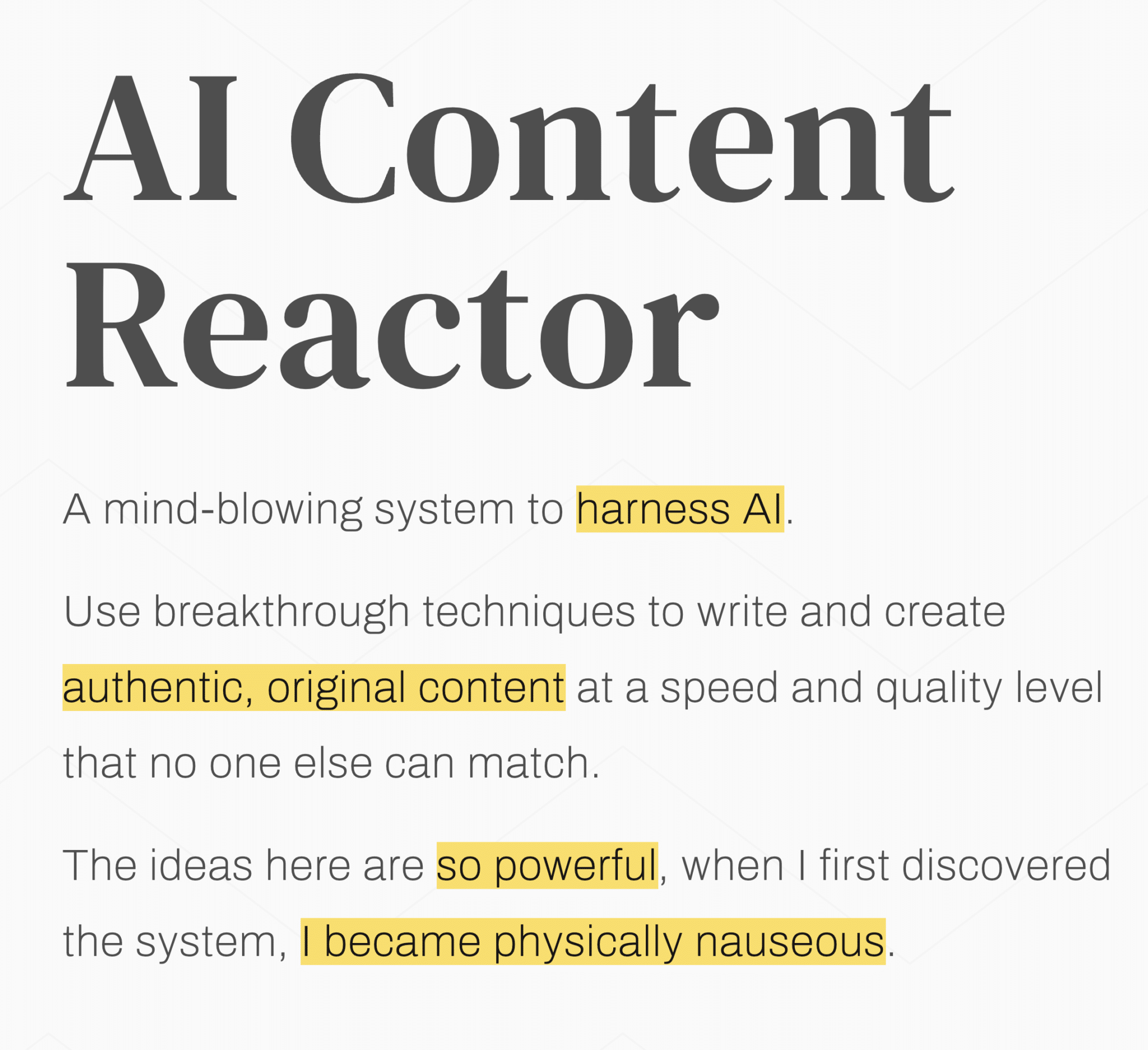Estimated reading time: 8 minutes
Table of contents
As a business owner with an online presence, how you present your products and your product description is important. This applies whether you own a brick-and-mortar store or operate exclusively online. The goal is to transform the art of physical display into an engaging website showcase that captures the attention of your audience.
Your First Impression – What does it say?
Have you ever experienced the disappointment of clicking on a product link that promises great value, only to land on a non-existent page? You click on the link and get…
- “Oops, we’re sorry, this page doesn’t exist.”
- “This product is out of stock, but you might be interested in a totally unrelated product.”
- “No image for this product. You’ll have to guess what it looks like.”
How many times has this happened to you? How tempted were you to look further on the site? Not very, probably.
Successful businesses understand the importance of creating a positive first impression. One vital aspect is to lead customers’ emotions, as we’ll discuss in the next section.
The Power of Emotional Connection
Design and marketing experts understand the significance of emotional buying. For instance, a well-crafted company logo, with the right colors and design, stirs positive emotions within consumers, encouraging purchases. In the digital space, our sight and hearing senses take precedence.
Visually, we can observe the texture of a product, assess a photographer’s skill, or gauge a shoe’s comfort level. Auditory clues, such as music samples, allow us to decide whether we’d like to purchase an entire album. It’s all about translating in-store sensory experiences into the online realm. We can’t touch, taste, or smell, so those other senses have to be engaged.
Showcasing Products – It’s All in the Details
Consider a diamond displayed on a velvety black background. That presentation suggests exclusivity and high class, setting the diamond apart from other gems. The same applies to your online products. How you display your products communicates your perception of them and, in turn, influences the consumer’s perception.
For instance, visit a high-end men’s store, and you’ll likely find suits and ties on wooden hangers. Wood, akin to black velvet for diamonds, accentuates the sophistication of the clothing. Similarly, a modern store might use brushed aluminum or glass displays to align with contemporary aesthetics.
So, what feeling does your product display evoke? Do you portray them as products worth owning? Your display doesn’t have to be extravagant, but it should make your products shine.
Building Customer Trust Through Detailed Descriptions
There’s a saying in business, “You can’t market a piece of junk.” While it’s possible to market anything (did you see the banana shoes??), the real value lies in gaining customer trust in your product. This trust serves as a foundation for all advertising and promotional efforts.
If your website is experiencing traffic but low sales conversions, it might be time to evaluate how you present your products. Here are some ways to address common issues and enhance your product presentation.
1. A Good Description
It’s surprising how many webmasters go through all the trouble of creating a beautiful website, complete with pictures of their products and separate pages for each one, yet they leave out one vital element: a proper product description. Without describing what people will actually get if they do buy, you’re making two potentially fatal mistakes.
First, you’re assuming visitors are already familiar with the product, what it does, and what it includes (and everyone knows what assuming does). A missing, inaccurate, or incomplete product description can ruin a sale.
Think about it. Aren’t you more likely to buy a product from a site with clear information than from a site with nothing but a picture and a “buy now” button? Of course, you are; you want to be able to verify what you’re purchasing, right? So do your buyers.
Your second error in this faulty assumption is that you’re taking a risk. People might purchase the wrong product, the wrong size, an item that is incompatible with what they intend to pair it with, etc.
Make sure your descriptions include the following:
- A general explanation of what the product is and what it does
- Benefits (value) of owning and using the product
- Most common applications of the product (in brief)
- Basic inclusions like batteries or accessories
- Requirements or separately-sold accessories that allow it to operate
Value, Benefit, Or Feature?
Don’t forget “Value vs. Benefit vs. Feature.” There are differences, and you need to understand them – especially in these economic times.
- Feature: what it does or has – A hood on a jacket is a feature
- Benefit: what you get from it – The hood keeps you warm, and can be pulled tight with sunglasses to mask your face if you want to rob a bank
- Value: where it saves you money – The hood is made out of durable material. You may have to buy a new jacket, but you won’t have to replace the hood for years.
If you wish to compete with or be listed on Amazon.com, you can take a cue from their product descriptions. As well, it’s a good idea to research what other successful online retailers have done, such as IKEA or Staples. Staples even makes purchasing envelopes sound like an adventure (check out that product description).
2. Detailed Specifications
While specs are not quite as important as a general description, in some cases (particularly with electronics), they can still make or break a sale. This is another situation where you can’t assume the potential customer knows everything about the product’s details. If they have to go to another site to find out what it does, what do you think the likelihood is that they’ll come back to your site to purchase?
Specifications must include:
- Dimensions (Size)
- Color
- Other possible custom orders (like alternate colors or designs)
- Optional accessories
- For electronics, outlets built-in, charger or batteries needed
- Specific, measurable parameters on the product’s technical operations
For example, a clock is just a clock, right? Wrong.
You have an off-white clock with a metallic sheen that stands 7” tall and 7” wide. The charming box shape is slightly dipped at the sides to allow for a contemporary touch. Snooze, On/Off and Set Time/Alarm buttons are within easy reach at the top for the days you want to sleep in just a little bit longer. A battery case holds two double AA batteries (not included) to turn your bedside clock into a friendly travel accessory.
When you’re talking sales, it’s all in the details.
3. Attractive And Informative Pictures
Naturally, you need to post a product picture, which must look professional. It needs to be taken with a high-quality camera with proper lighting and plain background (you never want the background to overwhelm the product). It should be cropped so it shows as closely as possible.
It’s also important to make sure your product pictures are taken from ample angles, if needed, to give a thorough, accurate, and honest image of what it truly looks (especially if it’s a product whose primary value to the consumer revolves around aesthetics).
4. Clearly Labeled Pricing And Shipping Charges
This is another “should go without saying” kind of rule – that sadly gets missed by an embarrassing number of webmasters. Put your pricing clearly near the top of your product page (usually next to the picture). It’s also helpful to give people an idea of what the shipping options and accompanying charges would be.
As a side note, having prominently displayed links to your shipping, returns, and privacy policies can go a long way in increasing consumer trust for the buys.
5. Consider Offering A Money-Back Guarantee
If you haven’t already done so, consider offering a 30-day money-back guarantee for your products. There are two main benefits this creates.
First of all, it adds credibility, which increases your conversion rate at the outset of the sales process. Visitors are more likely to buy something they aren’t 100% sure they want or need if they are given the chance to make the final decision later. They’re also less likely to return the product at all once they have it. Once you discover something works and have it in your hot little hands, you just might lose the motivation to actually return it.
But the real secret here, and the second benefit, is that it gives you valuable insight you can use moving forward.
A money-back guarantee tells you two crucial things:
- Which products or services are perceived as “better” in the eyes of your customers
- Which products or services need improvement
NOTE: Surveys and other types of questionnaires have a similar effect in terms of providing valuable insight into product improvement needs.
Money-back guarantees also ensure your customers get the products they actually want and need, which is quite likely to earn you repeat business.
Rating Systems Can Increase Buyer Trust
Providing a rating/review system for customer reviews increases buyer’s trust, although you’d better make sure you’re ready for negative feedback. If you decide to implement a rating system, create a plan for dealing with that negative feedback. Once it’s public, the worst thing you can do is delete it (witness the current Volkswagen social media fail). How will you show off your excellent customer service skills for the world to see?
Bottom Line: Presentation Makes A World Of Difference For Revenue
When you apply these rules to every product page, you have a properly written and formatted website in terms of presentation. Without it, you’re turning away numerous customers – perhaps the majority of your visitors – before they even get the chance to decide whether or not to seriously consider clicking the “buy now” link.
Creating a captivating product display online is an art that can make a significant difference in your revenue. Remember that the aim is to create a positive, lasting first impression. If they don’t purchase now, you want them to remember you later.
If you’re struggling to get your products off the online shelf, reach out to our team of professional marketing and SEO experts. With over 20 years in marketing and thousands of products described, we have the acumen to move the revenue needle.



































